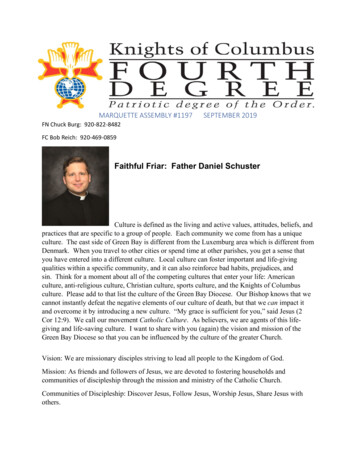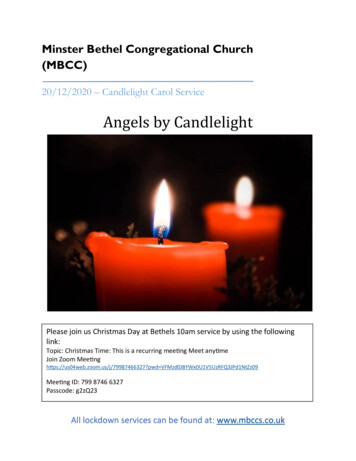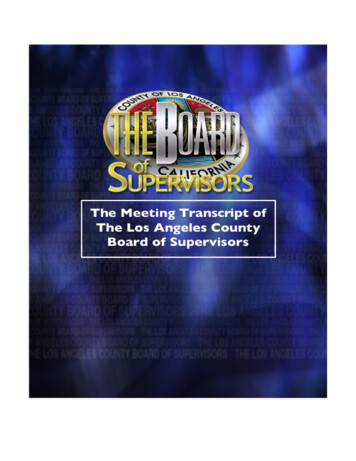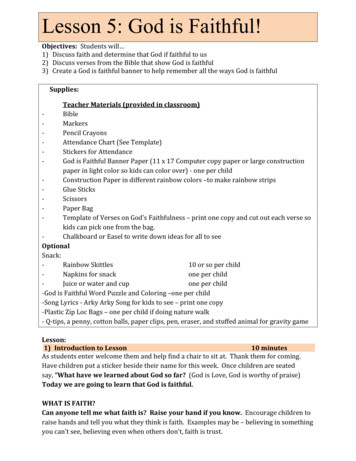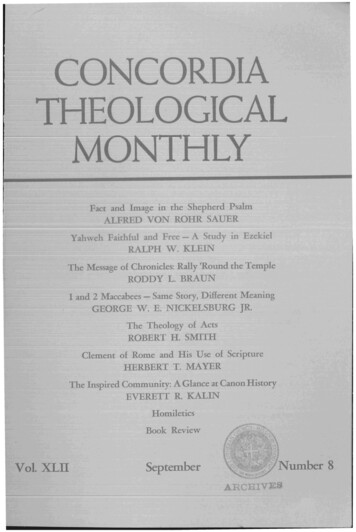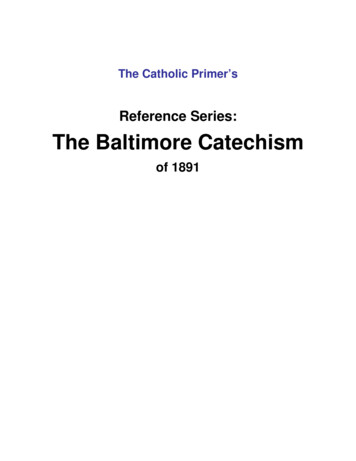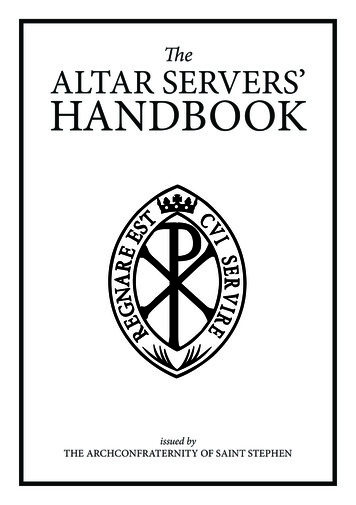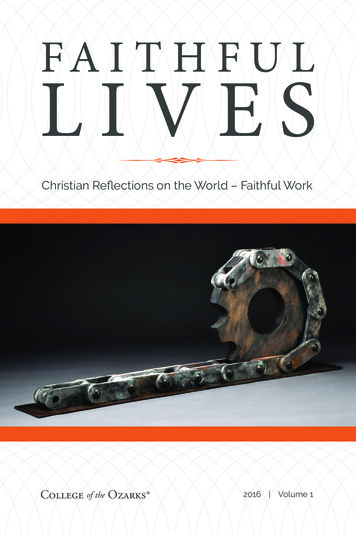
Transcription
FA I T H F U LLIVESChristian Reflections on the World – Faithful WorkCollege of the Ozarks 2016 Volume 1
FA I T H F U LLIVESChristian Reflections on the World – Faithful WorkCollege of the Ozarks 2016 Volume 1
The mission of College of the Ozarks is to provide the advantages of a Christianeducation for youth of both sexes, especially those found worthy, but who are withoutsufficient means to procure such training.Faithful Lives: Reflections on the World is an annual journal produced by College ofthe Ozarks. The goal of the publication is to foster deep and substantive Christianthought in all areas of life by publishing articles that assume and explore thetruthfulness of the Christian worldview perspective.Editoral BoardEric W. Bolger, Editor-in-ChiefWilliam R. Osborne, EditorAdvisory BoardBrad C. PardueStacy A. McNeillJustin R. CarswellAndrew BolgerRichard W. CummingsCopyright 2016 College of the Ozarks
Table of Contents5 From the EditorsEssays11 Edenic Endeavors: Sacred Service in the Garden of Edenby JAMES M. TODD, III21 The Idea of Vocation from a Historical Perspectiveby BRAD C. PARDUE29 Five Reasons Christians Should Embrace Economic Freedomby ANNE BRADLEY41 Have You Been Branded?: A Path to Healthy ChristianSelf-Promotionby JIM FREEMAN51 What Science Is, and What It Is Notby JOHN C. LENNOX63 Vocation as Implication: Learning to See Ourselves asResponsible, for Love’s Sake, for the Ways of the Worldby STEVEN GARBERReviews and Resources79 Business Ethics in Biblical Perspective: A ComprehensiveIntroduction by Michael E. Cafferky.Reviewed by SCOTT HALL83 WORK Curse or Calling? CIVA Artists (Christians in theVisual Arts) Explore the Subject of Work. Juried by Joel Zwart.Reviewed by RICHARD W. CUMMINGS
87 Matthew through Actsedited by Will Messenger.Reviewed by MARK RAPINCHUK91 Business for the Common Good: A Christian Vision forEconomics by Kenman Wong and Scott Rae.Reviewed by GARY HIEBSCH95 Where is God on Monday? by Alistair Mackenzieand Wayne Kirkland.Reviewed by WILLIAM R. OSBORNE
From the Editors“One thing conservative Christians don’t seem to realize is that [the]Bible clearly sees work as a curse (see Genesis story) & not a good thing,”tweeted a senior editor of a major news publication earlier this year.Being taken aback by the absolute lack of biblical knowledge revealedin this statement, I perused the unending stream of replies and thenbreathed a deep sigh of relief. Thankfully, thoughtful responses fromconcerned Christians addressed this falsity with fervor. It was evidentthe author of the tweet had clearly neglected the issue of work as it isaddressed in the Bible, but it was equally clear that there were manywho had thought deeply about the issue.The last three decades have seen a true resurgence in vocationtheology, resulting in Christians who are well-equipped to correctassumptions like the one above. From monographs to conferences,think tanks to sermon series, the topic of work has invaded Christianworldview thinking. Despite this widespread progress in thinking“Christianly” about work, sadly, a true Christian understanding of workstill evades many.While the topic of work has only recently garnered the attention itdeserves in the evangelical Christian world, it is not new to Christianthought. Some of the greatest minds of the last two thousand years havewrestled with the questions of how creation, the image of God, Christian calling, Christ’s death and resurrection, the Great Commandment,the Great Commission, and the new heavens and new earth affect theway we do our jobs on a given Tuesday morning in October. Do thesetruths change the way we think about our work? Absolutely. And itis these questions and more that have prompted this themed issue ofFaithful Lives focusing upon faithful work.One thinker who profoundly shaped this discussion is AbrahamKuyper (1837–1920). A famous Dutch theologian, Kuyper publishedtwo newspapers, started a university (The Free University ofAmsterdam), and later served as the Prime Minister of the Netherlands.It is staggering to think of emulating Kuyper’s accomplishments in atwenty-first century context! But it is precisely this breadth of experience that forced Kuyper to integrate his Christian convictions intoevery arena in which he found himself—business, church-state relations, higher education, and national politics.5
FAITHFUL LIVESKuyper’s unified perspective on work and faith is wonderfullycaptured in a sentence that has shaped the last thirty years of evangelical thought on work: “There is not a square inch in the whole domainof our human existence over which Christ, who is Sovereign over all,does not cry: ‘Mine!’” (Abraham Kuyper: A Centennial Reader, ed. JamesD. Bratt [Grand Rapids: Eerdmans, 1998], 488). Taken from Kuyper’sinaugural address at the dedication of the Free University, this ideaexposes the unifying principle that governed his worldview thinking—the sovereign reign of Christ.We live in a culture that celebrates the theme of diversity—and, inmany respects, rightly so. God is a marvelous creator: “O LORD, howmanifold are your works!” (Ps 104:24). Indeed, the world is diverse, Christianity as a global faith is diverse, and certainly our country is diverse. Butwhat happens when Christians elevate diversity above all other themes?How do we make sense of the pieces? In our culture, diversity is made toserve the greater goal of tolerance. But is tolerance a compelling reasonfor human purpose and existence? “Recognize and celebrate diversity sowe can tolerate each other.” Despite the bumper sticker campaign, coexistence is hardly a compelling reason to live and work.Surely there is a better unifying story that is big enough to absorb . . .make sense of . . . give value to . . . all of the diversity in our world. ThePauline version of Kuyper’s quote reads: “For in him all the fullness ofGod was pleased to dwell, and through him to reconcile to himself allthings, whether on earth or in heaven, making peace by the blood of hiscross” (Col 1:19–20, ESV). Through Christ, God is reconciling everysquare inch of life to himself—work included. When Christians neglectthis unifying vision, damaging theological assertions such as the tweetabove present work as merely a curse to be tolerated and endured.Reflecting on the theme of work as it applies to the Christian lifeis not a foreign idea for many of us, but that is especially true for ourlearning community at College of the Ozarks. Founded in 1906 byPresbyterian missionaries with the philosophy of working for an education, the school has been striving to live out “faithful work” since itsinception. College of the Ozarks is unique in that every student oncampus works 15 hours a week at a designated campus work stationalongside regular academic requirements. As a result, students do notpay tuition. As striking as this is in the midst of soaring tuition rates,the work program of the college does far more than offset operatingcosts and enable students to graduate debt-free. The college creates a6
From the Editorscommunity of learning and work that points students toward viewingtheir weekly work assignment as a worshipful task that serves both theLord and their neighbors.In our efficiency-driven, technologically-fractured culture, perhapsnow more than ever we need to present young men and women witha unified view of the world, so whether they are milking cows, servingtables, cleaning classrooms, or shelving books, they can see how theirwork is valuable in God’s eyes and contributing to his cosmic plan ofreconciliation. This journal and these essays are the product of muchwork carried out by many people, and it is our hope that they willencourage the faithful so that we might live out the words of Paul:“whether you eat or drink, or whatever you do, do all to the glory ofGod” (1 Cor 10:31).College of the Ozarks is publishing this journal because at the heartof the College’s mission is providing a distinctively “Christian” education, especially to worthy students who have significant financial need.Faithful Lives is one way the College can extend this distinctively Christian education to its alumni and friends.Living in a manner faithful to Jesus Christ in the twenty-first centuryrequires careful and biblically-grounded thinking on significant issues.Our first edition addresses one of these issues, the role of work inhuman life. Why did we choose this topic? Because it is one part of theCollege’s “five-fold” mission, which emphasizes academic, vocational,Christian, patriotic, and cultural growth. It seems appropriate that“Hard Work U. ” would inaugurate its new publication with a focus onthe topic of work.Our plans are to publish one edition per year, typically in the early fall.Next year’s edition will focus on faithful citizenship, reflecting anotherpart of the College’s five-fold mission, which is patriotic growth. Futureeditions will follow the same pattern.We are blessed to be part of an educational institution that has asignificant mission and that zealously guards that mission. Our prayeris that the reader might not only grow in understanding of a biblicalworldview, but also in appreciation for the College’s desire to serveChrist through its mission. We welcome your input and questions.Soli Deo GloriaEric W. BolgerWilliam R. Osborne7
FA I T H F U L L I V E SEssays
The Woman Who Remained Where She WasLisa LineOil on CanvasIn Woman Who Remained a solitary woman (the artist) peels potatoesin a field. Humanity exists in harmony with both the cultivated and thenatural. The Appalachian mountains in the background give a solidity andtimelessness to the painting, which reinforces the seemingly timeless,ever present process of work. Today’s potatoes are peeled; tomorrow’sawait. This work is from the exhibition WORK Curse or Calling? For a morecomplete review of the exhibition, see pg. 83.
Edenic Endeavors:Sacred Service in theGarden of EdenJames M. Todd, III*Throughout the millennia, work—being as basic to human existence as sleep and sustenance—has consumed a significant portion of our time as human beings on this earth. However, justas we are prone to misunderstand and misuse other good things, so toowe often misconstrue and distort work. In our present day, many do notunderstand the Bible’s teaching regarding work’s purpose and importance. Our current misunderstandings of work tend to express themselves in a couple common extremes. On one end of the spectrum arethe many people who dread going to work each day. For them, work’sfrustrations far outweigh any benefits their jobs might offer them. Workis simply a means to a paycheck, and countless popular songs reflectthe workweek’s drudgery by celebrating the freedom of the weekend.On the other end of the spectrum are those who find their identity intheir work. For these individuals, work provides them with a sense ofvalue and worth. Work is much more than a paycheck to them; it is thepurpose of their existence.However, many people fall somewhere between these two extremes.For these individuals, work provides a sense of fulfillment as they accomplish goals and do what they love, yet even in the midst of the joys ofwork, they experience frustration and hardship. While some struggle*James M. Todd, III, PhD serves as Assistant Professor of Biblical and Theological Studiesat College of the Ozarks in Point Lookout, Missouri. He is also the author of Sinai and theSaints: Reading Old Covenant Laws for the New Covenant Community (IVP Academic) and Remember,O Yahweh: The Poetry and Context of Psalms 135-137 (Wipf & Stock).11
FAITHFUL LIVESwith this perpetual tension, Christians should understand the reasonsfor this blend of blessings and curses, successes and failures, better thanothers. Not only do Christians experience this tension in their ownwork, but they also have theological explanations for it. The biblicalstory affirms work’s value and yet shows why humans experience frustrations, setbacks, and struggles as they work. It reveals that work isneither ultimate nor evil. Hating it or worshipping it only reveals a lackof understanding concerning work’s intended design and purpose.The best place to discover God’s design for work is the story ofGod’s creation of humanity in Genesis 1–2. In particular, the Edennarrative gives a snapshot of man’s work before sin and its associatedconsequences entered the world. My goal here is to simply draw backthe curtains of time and examine the nature of work initially in thegarden of Eden. I will discuss the royal, priestly, and undemandingcharacteristics of work in God’s grand design, with the hope that ourview of work will become more conformed to His intended purpose forour vocations. As I discuss each characteristic of work in Eden, I willdraw implications for our work in the present age as we anticipate thecomplete restoration of all things, including work in the new heavensand new earth.Work as a Royal TaskWhen discussing creation, one cannot separate the Eden narrative(Gen 2:4–3:25) from the creation narrative of Gen 1:1–2:3. The Edennarrative, especially Gen 2:4–25, gives a more detailed description ofthe events that transpired on Day 6 of creation (Gen 1:24–31). Genesis1 focuses on man’s cosmic responsibilities while the Eden narrativefocuses more specifically on man’s responsibilities in the garden. Therefore, any examination of man’s task in Eden must take into consideration the tasks God appointed for man in Genesis 1.Genesis 1:26–31 records God’s creation of human beings. As the lastcomponent of God’s creative work, human beings are the pinnacle ofGod’s world. In addition, by creating human beings in his own image,God distinguished them from the rest of his creation. The biblical textdoes not give a formal definition of what theologians call the imago dei(or the “image of God”), but the text does emphasize the role God’simage-bearers played in his world. God’s creation of humans (Gen 1:27)12
Essays Edenic Endeavors: Sacred Service in the Garden of Edenis sandwiched between two verses wherein God outlines his purposesfor humans. Verses 26 and 28 both emphasize man’s dominion over theother animals, and in verse 28, God instructs the humans in the followingmanner: “Be fruitful and multiply and fill the earth and subdue it” (v. 28).As humanity multiplied and spread across the world (v. 28), Godexpected them to exercise dominion over his creation. The great Kingof the universe granted his royal authority to those who bore his image,thus making them his vice-regents. Two specific things in Gen 1:26–28indicate that God viewed humans as his vice-regents. First, interpretingthe image of God as a royal designation coheres with a common understanding of the king in the ancient Near East. Egyptian and Mesopotamian societies often referred to their king as the “image of God.”1Second, the Hebrew word translated “have dominion” (vv. 26, 28) oftenappears in contexts that refer to a king’s rule.2 Psalm 8 confirms theroyal portrait of humans in Genesis 1 when it reads, “You have givenhim dominion over the works of your hands; you have put all thingsunder his feet” (v. 6).What bearing does this have on one’s understanding of mankind’swork in Eden? First, God’s transfer of power to human beings emphasizes the stewarding aspect of Adam’s and Eve’s existence. As vice-regents, their authority had its limits. Their lordship was not ultimate butwas subject to the King who created the world in which they worked.Their work should have accorded with God’s character and purposesfor his world. Second, Adam’s and Eve’s royal work reflected andextended God’s creative work in Genesis 1. God created a world thatwas good, but he also required humanity to develop his creation. WhenGod commanded Adam and Eve to “subdue” the earth, he intended forthem to extend their rule throughout the entire earth. As they extendedtheir rule, they would reflect their King’s creative and good nature. Infact, the Eden narrative provides an example of this creative aspect ofAdam’s royal dominion. After God “formed every beast of the field andevery bird of the heavens” (Gen 2:19), he brought these animals beforeAdam and tasked Adam with giving them names.Understanding our role as God’s vice-regents helps us view our workas an extension of God’s creative work. As we work in ways that reflect1T. Desmond Alexander, From Paradise to the Promised Land (3rd ed.; Grand Rapids: Baker,2012), 125.2Kenneth A. Mathews, Genesis 1–11:26 (New American Commentary 1a; Nashville: B&H,1996), 169.13
FAITHFUL LIVEShis character and excellence, we properly reflect his image in a fallenworld. Our tasks have meaning and purpose because they have beencommissioned by the King and serve his purposes for extending hisreign throughout the world. Such purposes are not limited to professional pastors and missionaries, but apply to all people, since all humanbeings are created in the image of God. However, Christians, whomGod is transforming into the image of his Son (Rom 8:29), have theability to showcase God’s ideal intentions for royal work in a world thathas rebelled against the King and thus perverted his good purposes.Work as a Priestly TaskMany scholars have observed significant parallels between thedescription of Eden and later biblical descriptions of the tabernacle andtemple. The following list represents some of these common features.31. The Lord walked in Eden and later sanctuaries (Gen 3:8;Lev 26:12; Deut 23:15; 2 Sam 7:6–7).2. The entrance faces east and is guarded by cherubim(Gen 3:24; Exod 25:18–22; 26:31; 1 Kings 6:23–29).3. The river flowing out of Eden serves as a prototype forEzekiel’s vision of a river that flows out of a new temple andrefreshes the Dead Sea (Gen 2:10–14; Ezek 47:1–12).4. Gold and onyx stones were used to decorate the tabernacle/temple and the priestly garments (Gen 2:11–12; Exod 25:7,11, 17, 24, 29, 36; 28:9, 20; 1 Kings 6:21–22).Because of these common features, scholars have identified Eden asthe first divine sanctuary. Eden, therefore, was not just a garden, it wasthe place where heaven and earth were one, the place where God dweltwith mankind, and naturally a fitting prototype for the later worshipsites Israel would build.The parallels between Eden and later sanctuaries also extend tothe man’s role in the garden. When God put Adam in the garden, heassigned the man two roles. Genesis 2:15 reads, “The Lord God tookthe man and put him in the garden of Eden to work it and keep it.”3Taken from Gordon J. Wenham, “Sanctuary Symbolism in the Garden of Eden Story”Proceedings of the World Congress of Jewish Studies 9 (1986): 400–402.14
Essays Edenic Endeavors: Sacred Service in the Garden of EdenThe Hebrew words translated “work” (‘ābad) and “keep” (šāmar) eachappear a second time in the Eden narrative. The word “work” appearsin Gen 2:5, when the text, in giving the reason for the lack of certainvegetation, states, “there was no man to work the ground.” Genesis2:15 therefore provides the remedy for the problem of Gen 2:5. Godput Adam in the garden and commanded him to work the garden sothat the ground could produce vegetation.The word “keep” appears after the fall of Adam and Eve and theirsubsequent expulsion from the garden. Genesis 3:24 describes thecherubim at the entrance of the garden and explains their purpose.The cherubim possessed a flaming sword in order “to guard the wayto the tree of life” (Gen 3:24). In this verse, the English translationscommonly translate the word šāmar as “guard.” Such a translationraises the question of Adam’s keeping in Gen 2:15. The word is notsynonymous with “work” but carries the connotation of “watchingover” something.4 From the immediate context of the passage, itappears that Adam’s responsibility in the garden was to work and watchover the garden.When we read the Eden narrative in the larger context of the Pentateuch, we discover that Adam’s tasks run deeper than simply tilling theground and watching out for critters. The words that describe Adam’sresponsibility frequently occur together in descriptions of the priests’responsibilities in the tabernacle (Num 3:7–8; 8:26; 18:4–6). The priestsministered before God in the tabernacle, guarded the tabernacle fromnon-priests, and maintained holiness in the camp. The use of priestlylanguage to describe Adam’s task in the garden underscores his priestlyrole.5 Since the garden was God’s sanctuary, God appointed Adam ashis priest to serve in his sanctuary. Like the later priests whose servicewas sacred, Adam’s work in the garden was not simply an activity bywhich Adam passed the time. It was a sacred service to the King inwhose temple Adam resided.Furthermore, Adam’s “watching over” the garden takes on a muchdeeper meaning when one understands his role as God’s priest. God4Ludwig Koehler, Walter Baumgartner, and M. E. J. Richardson, eds., The Hebrew and AramaicLexicon of the Old Testament (Accordance electronic edition; Leiden: Brill, 2000), 4:1581–4.5U. Cassuto, A Commentary on the Book of Genesis I (trans. Israel Abrahams; Jerusalem: MagnesPress, 1978), 122–3, interprets the parallel language to mean that working the ground wasnot part of Adam’s task in the garden, but a component of the fall. However, instead ofremoving the groundwork part of Adam’s task, the parallels between Adam and later priestsunderscore the sacredness of Adam’s groundwork15
FAITHFUL LIVEScommanded Israel’s later priests to guard the tabernacle from thosenot authorized to enter it (Num 3:7–8; 18:4–6). Therefore, Adam’s“watching over” the garden was probably much more important thansimply trimming the rose bushes. Adam’s “watching over” the gardenwas more like the cherubim’s guarding the garden after God expelledAdam and Eve. The cherubim protected the garden from those whodid not belong in it (ironically, those who did not belong in it wereAdam and Eve). Likewise, Adam’s guarding the garden meant that heshould maintain the holiness of God’s sanctuary. Thus, we should interpret Adam entertaining the serpent’s proposals as a failure to completehis task of guarding the holiness of God’s sanctuary.6When Adam and Eve disobeyed God in the garden, they forfeitedtheir right to serve as priests in God’s sanctuary. Hence, God later setapart a certain group of people to serve as priests in his sanctuaries.Ultimately, these Old Testament sanctuaries pointed toward God’strue temple, Jesus Christ (John 2:19–21). As the embodiment of God’spresence, Christ “dwelt among us” (John 1:14). After Jesus’ ascension into heaven, the Holy Spirit came and filled all believers with thedivine presence, thus making the church a temple (Eph 2:21–22) andall believers priests (1 Peter 2:9).7 As God’s temple and priesthood, thechurch, like Israel’s priesthood, mediates God’s blessings to the entireworld by proclaiming the good news of Jesus Christ. Furthermore, sinceChristians serve as God’s priests, all of life becomes sacred, includingour work. Therefore, the compartmentalized categories of sacred andsecular do not exist for kingdom workers.Work as an Undemanding TaskIn the previous two sections, I have emphasized Adam’s role asGod’s king-priest in his Edenic sanctuary. For many readers, such information is sufficient, but they want more details about work in Eden.Did Adam and Eve sweat? Did their backs hurt? What was it like towork in a garden without weeds? Numerous questions arise when weread the narrative, and unfortunately, we cannot answer all the specific6Alexander, From Paradise to the Promised Land, 127.7For a good discussion of how Christians live as God’s priests, see G. K. Beale, The Temple andthe Church’s Mission: A Biblical Theology of the Dwelling Place of God (Downers Grove, IL: IVP,2004), 395–402.16
Essays Edenic Endeavors: Sacred Service in the Garden of Edenquestions. However, the Eden narrative does provide some further cluesregarding the nature of work in the garden.Adam and Eve had it all. They had a beautiful garden in which towork and play; they had dominion over all things; and most importantly, they had unhindered access to God’s presence. Yet, Adam andEve failed to enjoy the paradisiacal place God had given them. Theychose to disobey God’s command and thereby forfeited the blessingsof the garden. In response, God punished them. Their punishments,along with the serpent’s cursing, appear in Gen 3:14–24. Of the variouspunishments, Adam’s punishment (Gen 3:17–19) is the most significantfor our present investigation.After reminding Adam of his sin (3:17), God curses the groundbecause of Adam (Gen 3:17). God’s curse of the ground relates directlyback to his creation of Adam from the ground in 2:7 and Adam’s tasksin 2:15. Since Adam’s work dealt primarily with the ground, God’scurse of the ground directly affected Adam’s work. By looking at thedescription of the ground’s curse, we can deduce what Adam’s workmight have been like before his fall.Genesis 3:17–19 outlines the results of the cursed ground bydescribing what the ground would now produce and how such a changeaffected Adam’s work. In addition to vegetation and trees that providedfood for mankind (Gen 1:29), the ground would also produce “thornsand thistles,” vegetation that contrasts the trees of the garden, whichwere “pleasant to the sight and good for food” (Gen 2:9). In order toget what he needed for sustenance, Adam would now face resistancefrom unpleasant and fruitless plants. The passage also describes howAdam’s work would change. Genesis 3:17 describes his work as “pain”8or “toil,” and Gen 3:19 states that he would eat with a sweat-coveredforehead. Taken together, these two descriptions of Adam’s work indicate that his work would be toilsome and unpleasant.The ground’s curse ushered in significant changes in the nature ofAdam’s work, changes which help interpreters clarify the nature ofAdam’s work before the fall. First, the description of Adam’s work aspainful helps us understand that Adam’s work in Eden was not “anxioustoil,” but easy work.9 The grit, grime, and grind of work as we know8The same word appears in Genesis 3:16 to describe the pain of childbirth.9Koehler, Baumgartner, and Richardson (2:865) translate this word as “anxious toil, hardship.”17
FAITHFUL LIVESit did not exist before the fall. Second, the mention of Adam’s sweatcovered forehead underscores the ground’s resistance. Adam’s work inthe garden probably required physical exertion, but in contrast to workoutside the garden, it did not result in physical exhaustion. The workin the garden was probably a refreshing, relaxing activity that not onlyrenewed the ground, but also renewed the one working the ground.Unlike work after Adam’s and Eve’s expulsion from the garden, work inEden did not cause Adam and Eve to cry out for comfort (cf. Gen 5:29).During difficult or exhausting times of work, we may be temptedto blur the lines between work itself and the fall’s impact on our work,consequently viewing work as part of the fallen world. The Eden narrative reminds us that our work is not a product of the fall, and like allthings in the present age, suffers from the distorting effects of a cursedcreation. Just as Lamech longed for comfort from the hardships of thecursed ground in his day (Gen 5:29), we should look forward to theday when God removes creation’s curse (Rom 8:18–23) and our workbecomes an undemanding task in the renewed creation (Rev 21–22).Work in the Second EdenAfter Adam and Eve leave the garden, the biblical story continuesby describing God’s plan of redemption and ultimate restoration.Throughout the Old Testament, God gives numerous propheciesregarding his future restoration of all things. This plan centers onthe person and work of Jesus Christ, who began restoring all thingsby suffering for the world’s sins. Although Jesus inaugurated God’skingdom with his first coming, believers still wait for the kingdom’sconsummation at Jesus’ second coming. The book of Revelation givesa vivid description of God’s consummated kingdom. Attentive readerswill notice that the consummated kingdom has some familiar imagery.Revelation 21:1–22:5 describe the new heavens and the new earth. Inthis section, John focuses primarily on the new Jerusalem (Rev 21:2–27)and the beautiful park in its midst (Rev 22:1–5), a park that resemblesthe original Eden. Like the first Eden, the second Eden contains a Treeof Life, has a river, is devoid of sin’s curse, and is God’s dwelling placeon earth. Eden has returned and is even better than the first Eden.18
Essays Edenic Endeavors: Sacred Service in the Garden of EdenChristians often wonder about life in the new Jerusalem.10 What willwe do? What will we look like? Revelation does not give many detailsabout human activities on the new earth, but it is likely that manyactivities will parallel those in the garden. Given the intentional andclear parallels with the Eden narrative, we may safely assume that workwill be a part of our eternal existence in the new Jerusalem. As Adamand Eve had a sacred task in the garden, so too the inhabitants of thenew earth will have sacred tasks. In fact, John’s description of the newJerusalem echoes the three-fold nature of work outlined in this article.First, Rev 22:5 states that God’s servants “will reign forever and ever,”thus echoing Adam’s royal task in the garden. Second, Rev 22:3 states,“his [God’s] servants will worship him.” The Greek word translated“worship” refers to carrying out religious duties, in particular, priestlyduties.11 Such activity parallels Adam’s priestly role in the garden.12Finally, Rev 22:3 states that the curse will not be present in the newJerusalem. The absence of the curse explains why there will be no morepain (Rev 21:4). The lack of the curse and pain demonstrates that man’swork in the second Eden will once again be undemanding work in God’sdwelling place. Eternity for believers is not sitting on cl
inception. College of the Ozarks is unique in that every student on campus works 15 hours a week at a designated campus work station alongside regular academic requirements. As a result, students do not pay tuition. As striking as this is in the midst of soaring tuition rates, the work program of the college does far more than offset operating


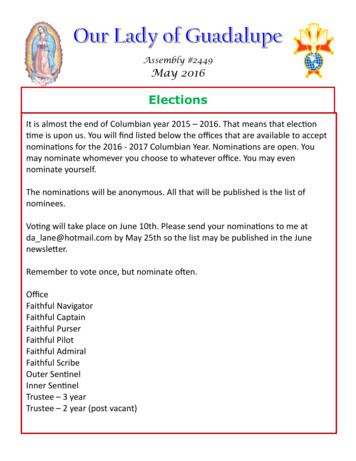

![Prayer of the Faithful 2022 [eBook]](/img/18/30146865.jpg)
